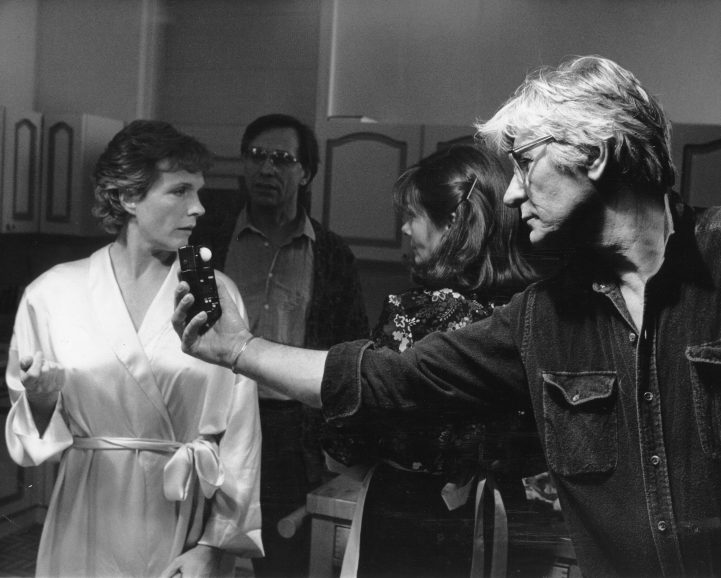TAILOR-MADE FOR THE JOB
A chance encounter between his father and a top producer kickstarted Alex Thomson BSC’s prestigious cinematography career, which later saw him become BSC president and one of its long-serving board members.
Born in 1929 in London, the son of a Bond Street tailor, Alex Thomson BSC underwent an operation at the age of five which left him totally deaf in his left ear. As a consolation he was taken to the cinema for the first time, and in his own words, “from that moment on I was hooked”.
Thomson went to school in Kingsbury, North West London until the age of 14, “having learnt virtually nothing”. One day, his father happened to be making a suit for Sir Anthony Havelock-Allan, who, at that time, was in partnership with Sir Noël Coward, Sir David Lean CBE and Ronald Neame CBE BSC in a company called Cineguild, based at Denham Studios. During the fitting, Thomson’s father spoke of his son’s love of cinema and Havelock-Allan replied, “Send the boy down to the office and I’ll take a look at him.”

At Denham, Havelock-Allan introduced Thomson to Bert Easey BSC, the head of the camera department, and two years later, after working as a trainee projectionist at the Gaumont cinema in Camden Town, he became a clapper boy for Denham Studios ca. 1949. By 1961 he was operating on the film Information Received (dir. Robert Lynn) photographed by Nicolas Roeg CBE BSC, with whom he began a long friendship and collaboration on films such as Lawrence of Arabia (second unit) (1962, dir. David Lean, cin. Freddie Young OBE BSC), Nothing But the Best (1964, dir. Clive Donner), The Masque of the Red Death (1964, dir. Roger Corman), Fahrenheit 451 (1966, dir. François Truffaut) and Far From the Madding Crowd (1967, dir. John Schlesinger CBE).
In 1967, director Clive Donner offered Thomson his first film as cinematographer: Here We Go Round the Mulberry Bush, which was a modern romance set in ‘swinging ’60s Stevenage’. It was followed by the ‘commercially disastrous’ Alfred the Great (1969), again directed by Clive Donner, set in a ninth-century England.
A number of mediocre films followed, but Thomson had a chance to prove himself on Jesus Christ Superstar (1973, dir. Norman Jewison) for Universal Pictures. Unhappily, during the first week of filming, he fell off the camera rostrum, seriously injuring himself and was replaced by Douglas Slocombe OBE BSC, who went on to win the BSC Best Cinematography for the film.

After his recovery, more mid-range films followed and it wasn’t until Excalibur (1981, dir. John Boorman) that Thomson was elevated into the top echelon of cinematographers, earning an Oscar nomination and a BSC Best Cinematography nomination for the film. As a result, Nicolas Roeg chose Thomson to photograph Eureka (1983) and later Track 29 (1988), described by Ronald Bergan in The Guardian as ‘two self-indulgent but visually haunting films.’ Thomson eventually won the BSC Best Cinematography award for Ridley Scott’s sumptuous fairy tale, Legend (1985). Amongst his other credits are Year of the Dragon (1985, dir. Michael Cimino), Labyrinth (1986, dir. Jim Henson), The Sicilian (1987, dir. Michael Cimino), which he considered a favourite of all his films, and Alien3 (1992, dir. David Fincher).
In 1996, he photographed Hamlet (dir. Kenneth Branagh) in 65mm, winning a BSC Best Cinematography award and a Camerimage Golden Frog nomination. Producer David Barron said: “on a film of this nature, acting and directing is quite enough to worry about… I knew we could rely on Alex’s wealth of knowledge and experience.” Thomson went on to photograph another Shakespeare adaptation, Loves Labours Lost (2000), with Branagh. His last credited feature film is A Shot at Glory (2000, dir. Michael Corrente).

He became a BSC member in 1968 and was one of the longest-serving board members from 1977 to 2007, as well as president from 1980 to 1982. During his tenure, Thomson compiled and edited the seminal book Outstanding Stills using on-set stills of BSC members since the beginning of cinema in the UK, published by the BSC.
Thomson was married to the sculptor Diana Thomson FRSS who, in 1999, was commissioned by the BSC to make a bust of motion picture camera pioneer William Friese-Greene, one of which adorns the administration building at Pinewood Studios. Thomson’s daughter, Chyna, has also worked in the camera department.
Thomson’s other credits include: Dr. Phibes Rises Again (1972), The Cat and the Canary (1978), The Keep (1983), Leviathan (1989), The Krays (1990), Cliffhanger (1993), Demolition Man (1993), and Black Beauty (1994). His selected awards include Oscar and BSC Best Cinematography nominations for Excalibur (1981, dir. John Boorman); BSC Best Cinematography wins for Legend (1985, dir. Ridley Scott) and Hamlet (1996, dir. Kenneth Branagh); Satellite Awards and Camerimage Golden Frog nominations for Hamlet; and the BSC Lifetime Achievement Award in 2002.











